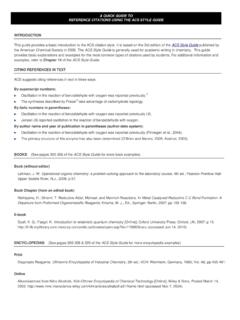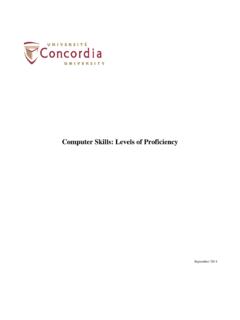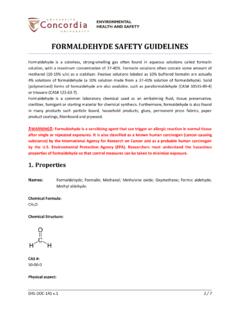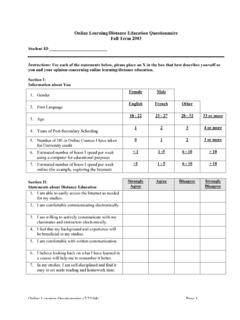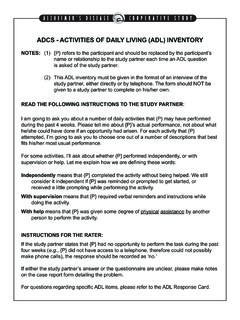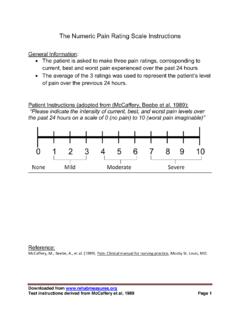Transcription of The Montreal Cognitive Assessment (MoCA): Concept and ...
1 The Montreal Cognitive Assessment ( moca ): Concept and Clinical Review Authors: Parunyou Julayanont, Natalie Phillips, Howard Chertkow, and Ziad Nasreddine Version: February 18, 2012 Julayanont, P., Phillips, N., Chertkow, H., and Nasreddine, The Montreal Cognitive Assessment ( moca ): Concept and Clinical Review. To appear in Larner (Ed.), Cognitive Screening Instruments: A Practical Approach. Springer-Verlag, pp. 111-152. The Montreal Cognitive Assessment ( moca ): Concept and Clinical Review 1. Introduction The Montreal Cognitive Assessment ( moca ) was developed as a brief screening instrument to detect mild Cognitive impairment .
2 (1) It is a paper-and-pencil tool that requires approximately 10 minutes to administer, and is scored out of 30 points. The moca assesses multiple Cognitive domains including attention, concentration, executive functions, memory, language, visuospatial skills, abstraction, calculation and orientation. It is widely used around the world and is translated to 36 languages and dialects. The test and instructions are freely available on the moca official website at No permission is required for clinical or educational use. This chapter will describe how each moca sub-test/domain, assesses various neuro-anatomical areas, and often overlapping Cognitive functions.
3 A comprehensive review of studies using the moca in multiple clinical settings and populations is provided. An algorithm for using the moca in clinical practice is suggested. In conclusion, moca limitations, future research and developments are discussed. 2. Cognitive Domains assessed by the moca Visuospatial/Executive Modified Trail Making Test Beside visuomotor and visuoperceptual skills, the trail making test B (TMT-B) requires mental flexibility to shift between numbers and letters which mainly rely on frontal lobe function (2 5).
4 In functional Magnetic Resonance Imaging (fMRI) studies, shifting ability in the TMT-B revealed greater activation relative to the trail making test A in the left dorsolateral and medial frontal cortices, right inferior and middle frontal cortices, right precentral gyrus, left angular and middle temporal gyri, bilateral intraparietal sulci (6 8). A study of patients with frontal and non-frontal lobe lesions reported that all patients who had more than one error in the TMT-B had frontal lobe lesions. Specifically, patients with damage in the dorsolateral frontal area were mostly impaired(9).
5 Left frontal damage tended to cause more impairment than controls and right frontal damage groups, either for execution time or number of errors(10). Nonetheless, specificity of the TMT-B to frontal lobe lesions is debated as one study reported comparable performance between frontal and non-frontal stroke patients(11). Copy of the Cube The Montreal Cognitive Assessment ( moca ): Concept and Clinical Review Authors: Parunyou Julayanont, Natalie Phillips, Howard Chertkow, and Ziad Nasreddine Version: February 18, 2012 To copy a cube, subjects have to initially convert a two-dimensional contour to a three-dimensional cube.
6 This ability is enhanced by learning experiences(12,13). After spatial planning, visuomotor coordination also plays a role in copying the cube. Various brain areas are involved; visual perception in the parieto-occipital lobe, planning in the frontal lobe, and integration of visual and fine motor sequences in the fronto-parieto-occipital cortices. The Cognitive mechanisms underlying performance in copying a figure are different according to the underlying disease. Alzheimer s disease (AD) patients with spatial perception/attention impairment had significant atrophy in the right parietal cortex.
7 Complex two-dimensional figure copy were negatively associated with degree of right inferior temporal atrophy and reduction of cerebral blood flow in the right parietal cortex (14,15). Patients with behavioral variant fronto-temporal dementia had spatial planning and working memory dysfunction had significant atrophy in the right dorsolateral prefrontal cortex (16). A correlation between neuro-imaging and cube copying specifically, has not yet been reported. Even though, a high proportion of either normal subjects (40%) or Alzheimer patients (76%) performed poorly on cube drawing on verbal command, persistent failure to copy a cube from a previously drawn cube is highly discriminative to detect patients with Alzheimer s disease (17).
8 Less educated, older age, female and depressed subjects performed poorly in drawing-to-command and copying conditions. The Clock Drawing Test The Clock Drawing Test (CDT) has been widely used and studied for detection of dementia and mild Cognitive impairment . Planning, conceptualization, and symbolic representation are involved in drawing a clock s face and in placing all the numbers correctly(18,19). Inhibitory response is required when placing each hand to tell the time of ten past eleven . Self-initiated-clock-drawing also requires intact visuoconstructive skills which are mainly represented in the parietal lobe.
9 In volunteers, fMRI demonstrated bilateral activation of the posterior parietal cortex and the dorsal premotor area during task performance suggesting the contribution of the parieto-frontal cortical networks to integrate visuospatial elements and motor control in self-initiated clock drawing(20). In AD patients, errors in CDT were mainly conceptual and due to semantic memory impairment (21 23). This was supported by various neuroimaging studies that found negative correlation between CDT performance and atrophy of the right/left temporal cortices (24,25), atrophy of the medial temporal lobe (23), reduction in the activation of the left superior parietal lobe (26), and hypo metabolism of the right parietal cortex (27) in patients with Cognitive impairment caused by AD pathology.
10 White matter hyperintensities (WMH) is also related to performance on CDT (23). Patients with severe WMH and patients with Parkinson s disease (PD) performed poorly and similarly on all subscales of CDT(28). Even though The Montreal Cognitive Assessment ( moca ): Concept and Clinical Review Authors: Parunyou Julayanont, Natalie Phillips, Howard Chertkow, and Ziad Nasreddine Version: February 18, 2012 both groups were different in term of neuropathology, they both have disrupted subcortico-frontal pathways. PD affects the subcortical dopaminergic pathway projecting to the prefrontal cortex (28,29).
